CBSE Board 10th Mid Term Exam 2024-25 : Science (Physics) Most Important Questions with Answers
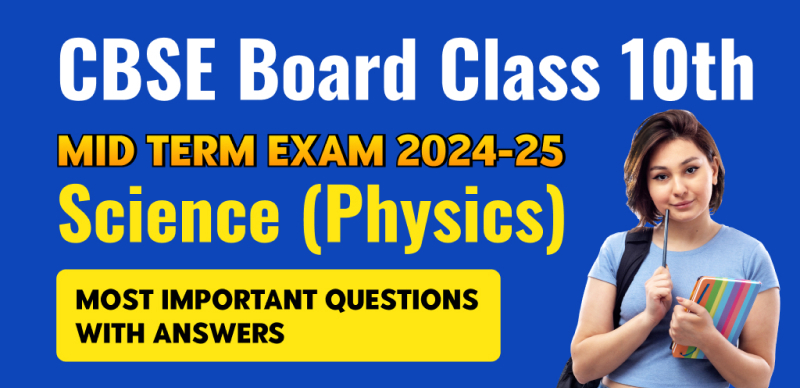
SHARING IS CARING
If our Website helped you a little, then kindly spread our voice using Social Networks. Spread our word to your readers, friends, teachers, students & all those close ones who deserve to know what you know now.
As the CBSE Class 10th mid-term or half-yearly exams approach, students are focusing on key subjects like Science, especially Physics. To help you prepare effectively, we've compiled a list of the most important Physics questions for your mid-term exams. These questions cover essential topics and will give you a solid foundation for your studies.
👉 Read Also - CBSE Board Class 10th Mid Term Exam 2024-25 : Maths Most Important MCQs with Answers
👉 Read Also - CBSE Board 10th Mid Term Exam 2024-25 : Most Important English Grammar Question with Answers
Most Important Science (Physics) Questions for Mid Term Exam
Q1. In case of a real and inverted image the magnification of a mirror is
(a) positive and large.
(b) negative.
(c) positive and small.
(d) negative and large.
Ans. (b) negative.
Q2. A concave mirror gives real, inverted and same size image if the object is placed
(a) At F
(b) At C
(c) At infinity
(d) Beyond C
Ans. (b) At C
Q3. A concave mirror gives virtual, erect and enlarged image of the object. The position of the object is
(a) At infinity
(b) Between F and C
(c) Between P and F
(d) At F
Ans. (c) Between P and F
Q4. A linear object is place at a distance equal to focal length of a convex mirror. Its image is formed
(a) At infinite distance
(b) At the principal focus of mirror
(c) Behind the mirror at a distance f/2
(d) In front of mirror at a distance f/2
Ans. (c) Behind the mirror at a distance f/2
Q5. Assertion: Concave mirrors are used as reflectors in torches, vehicle head-lights and in search lights.
Reason: When an object is placed beyond the centre of curvature of a concave mirror, the image formed is real and inverted.
(a) Both the Assertion and the Reason are correct and the Reason is the correct explanation of the Assertion.
(b) The Assertion and the Reason are correct but the Reason is not the correct explanation of the Assertion.
(c) Assertion is true but the Reason is false.
(d) The statement of the Assertion is false but the Reason is true.
Ans. (b) The Assertion and the Reason are correct but the Reason is not the correct explanation of the Assertion.
👉 CBSE Class 10 Study Materials
| CBSE Class 10 Syllabus 2024-25 | NCERT Solutions For Class 10 |
| CBSE Class 10 Previous Year Question Papers | CBSE Class 10 Books |
| CBSE Class 10 Full Study Material | CBSE Class 10 Sample Paper |
Q6. Assertion: Convex mirror are used for rear view on vehicles.
Reason: The size of the image formed by a convex mirror will be same.
(a) If both assertion and reason are true and reason the correct explanation of assertion.
(b) If both assertion and reason are true, but reason i not the correct explanation of assertion.
(c) If assertion is true, but reason is false.
(d) If If assertion is false but reason is true.
Ans. (c) If assertion is true, but reason is false.
Q7. Assertion: The word AMBULANCE on the hospital vans is written in the form of its mirror as ECNALUBMA.
Reason: The image formed in a plane mirror is same size of the object
(a) Both the Assertion and the Reason are correct and the Reason is the correct explanation of the Assertion.
(b) The Assertion and the Reason are correct but the Reason is not the correct explanation of the Assertion.
(c) Assertion is true but the Reason is false.
(d) The statement of the Assertion is false but the Reason is true.
Ans. (b) The Assertion and the Reason are correct but the Reason is not the correct explanation of the Assertion.
Q8. A concave mirror produces three times magnified real image of an object placed at 10 cm in front of it. The image is located at
(a) 30 cm
(b) 40 cm
(c) 10 cm
(d) 90 cm
Ans. (a) 30 cm
Q9. For the diagram shown, according to the new Cartesian sign convention the magnification of the image formed will have the following specifications:
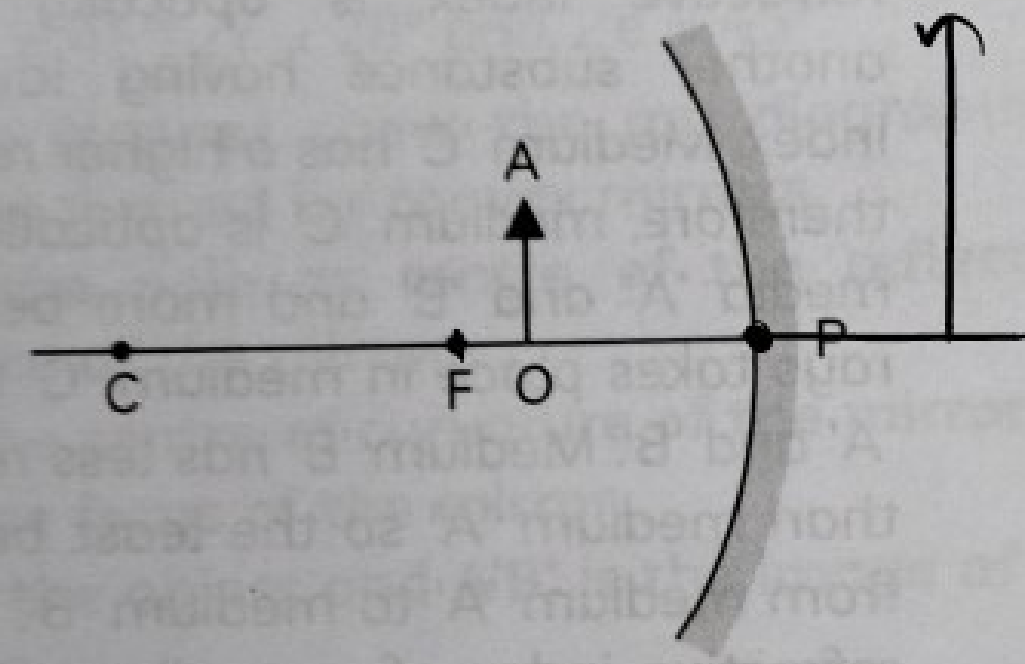
(a) Sign - Positive, Value - Less than 1
(b) Sign - Positive, Value - More than 1
(c) Sign - Negative, Value - Less than 1
(d) Sign - Negative, Value - More than 1
Ans. (b) Sign - Positive, Value - More than 1
Q10. A concave mirror of focal length 20 cm forms an image having twice the size of object. For the virtual position of image, the position of object will be at
(a) 25 cm
(b) 40 cm
(c) 10 cm
(d) At infinity
Ans. (c) 10 cm
Q11. If a man's face is 25 cm in front of concave shaving mirror producing erect image 1.5 times the size of face, focal length of the mirror would be
(a) 75 cm
(b) 25 cm
(c) 15 cm
(d) 60 cm
Ans. (a) 75 cm
Q12 Refractive indices of medium A, B and C are 1.3, 1.5 and 1.4 respectively. In which of the following the speed of light will be the :
(a) fastest (b) slowest and why?
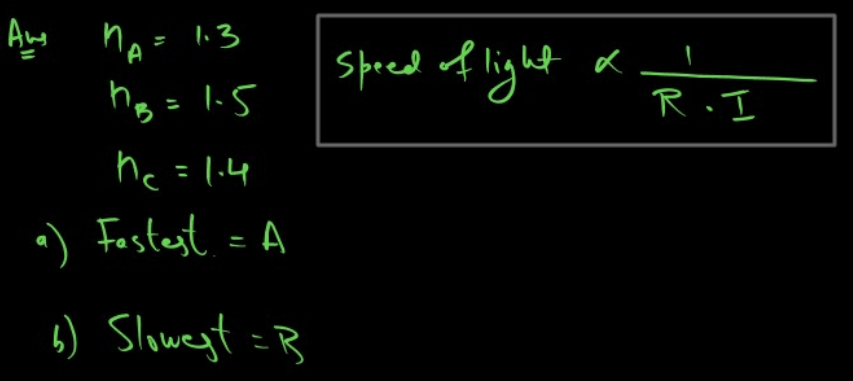
Q13. The refractive index of glass is 1.5, what is meant by this statement? (b) Refractive indices of glass, kerosene and water are 1.5, 1.44 and 1.33 respectively. Arrange them in ascending order of their optical density.
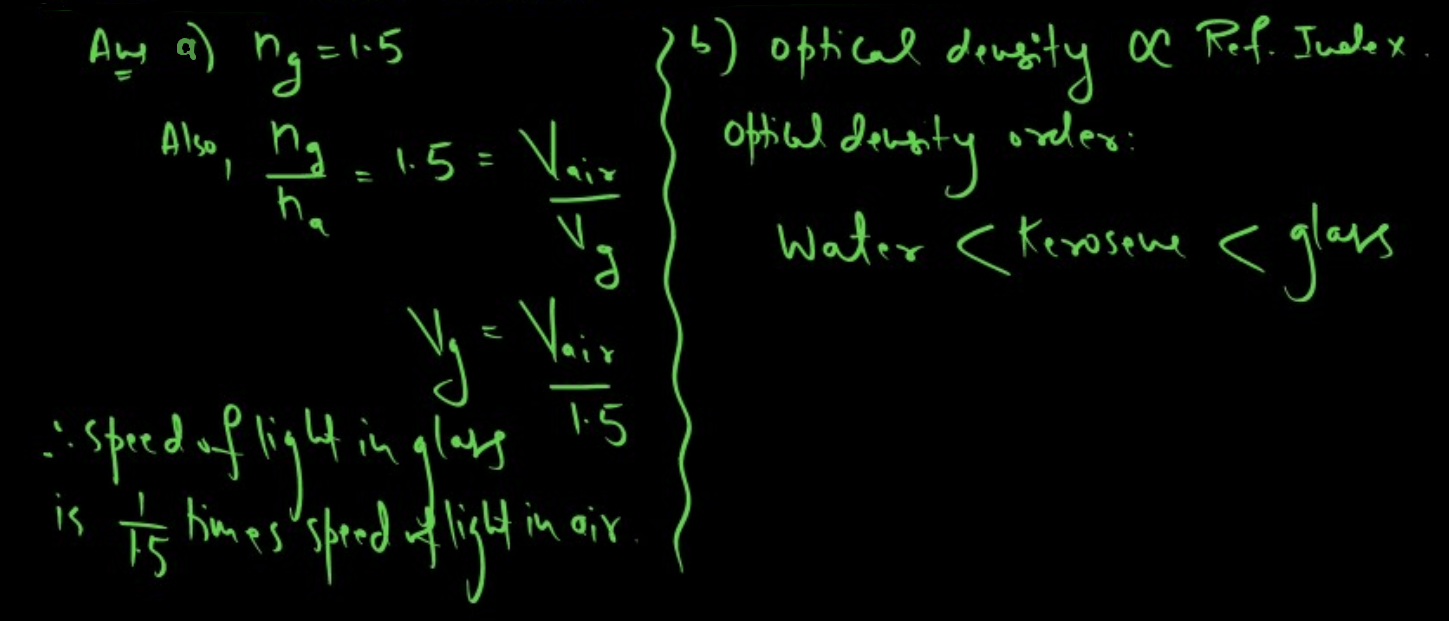
Q14. The refractive index of transparent medium is greater than one because
(a) Speed of light in vacuum < speed of light in transparent medium
(b) Speed of light in vacuum > speed of light in transparent medium
(c) Speed flight in vacuum = speed of light in transparent medium
(d) Frequency of light wave changes when it moves from rarer to denser medium
Ans. (b) Speed of light in vacuum > speed of light in transparent medium
Q15. A compound lens is made up of two thin lenses having power + 12.5 Dand - 2.5 D. Find the focal length and power of the combination.
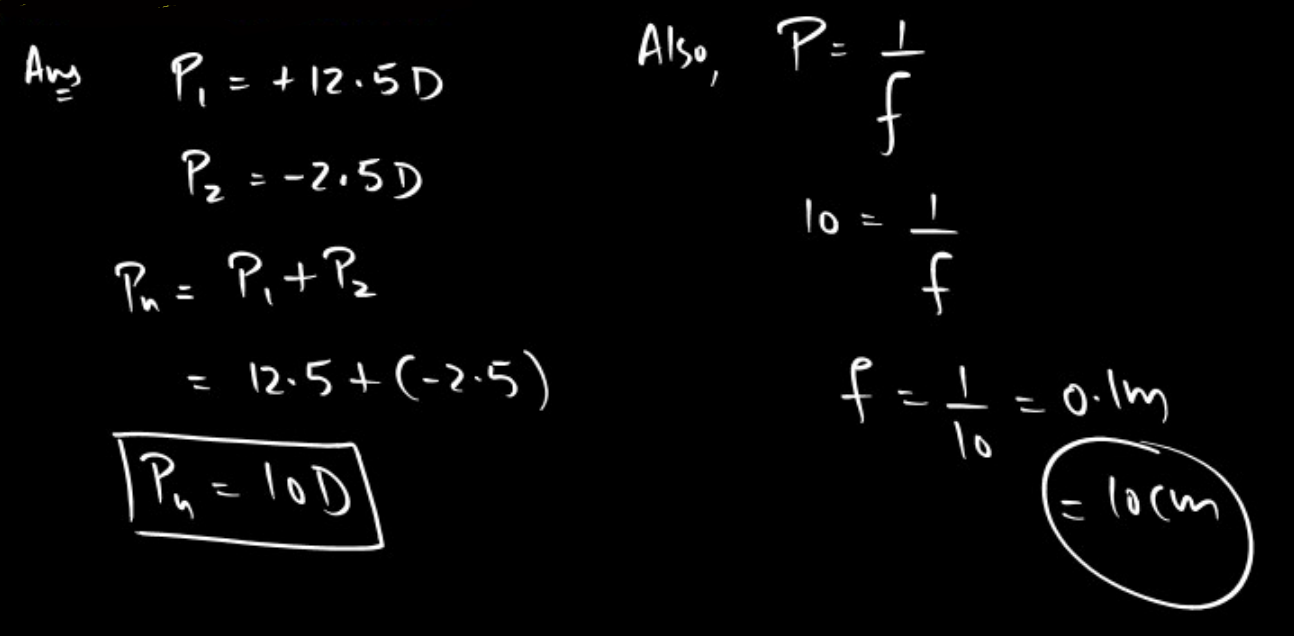
Q16. A student obtains a blurred image of distant object on a screen using a convex lens. To obtain a distinct image on the screen he should move the lens.
(a) away from the screen
(b) towards the screen
(c) to a position very far away from the screen
(d) either towards or away from the screen depending upon the position of the object.
Ans. (d) either towards or away from the screen depending upon the position of the object.
Q17. Study the given ray diagrams and select the correct statement from the following:
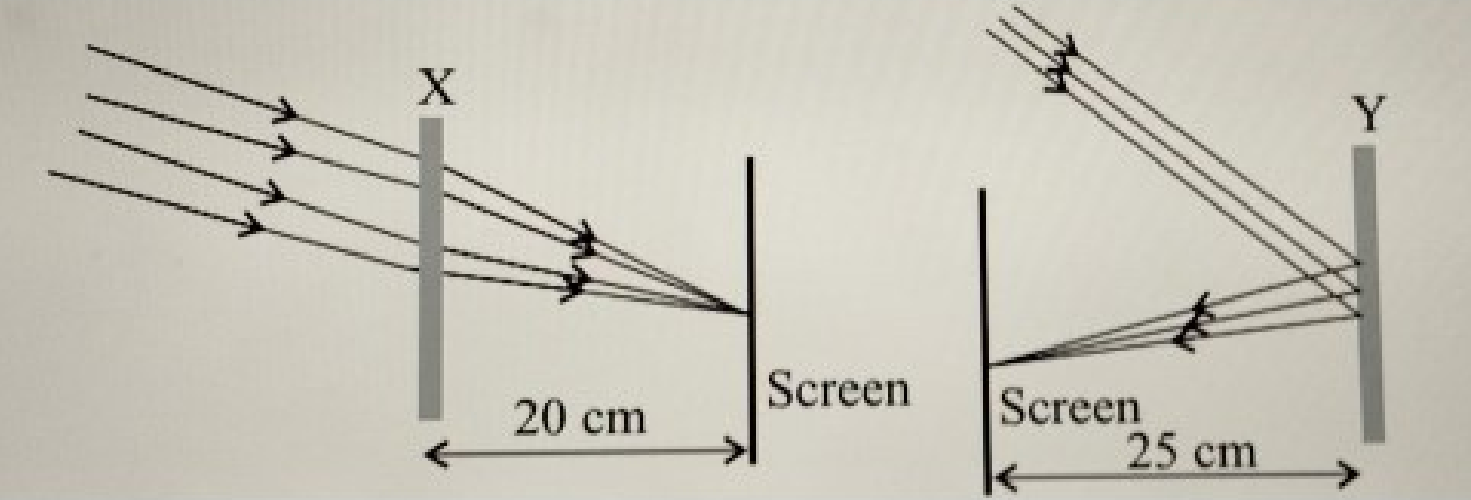
(a) Device X is a concave mirror and device Y is a convex lens, whose focal lengths are 20 cm and 25 cm respectively.
(b) Device X is a convex lens and device Y is a concave mirror, whose focal lengths are 10 cm and 25 cm respectively.
(c) Device X is a concave lens and device Y is a convex mirror, whose focal lengths are 20 cm and 25 cm respectively.
(d) Device X is a convex lens and device Y is a concave mirror, whose focal lengths are 20 cm and 25 cm respectively.
Ans. (d) Device X is a convex lens and device Y is a concave mirror, whose focal lengths are 20 cm and 25 cm respectively.
Q18. A person cannot see distinctly objects kept beyond 2 m. This defect can be corrected by using a lens of power
(a) + 0.5 D
(b) - 0.5 D
(c) + 0.2 D
(d) - 0.2 D
Ans. (b) - 0.5 D
Q19. The focal length of the eye lens increases when eye muscles:
(a) are relaxed and the lens becomes thinner
(b) contract and the lens becomes thicker
(c) are relaxed and the lens becomes thicker
(d) contract and the lens becomes thinner
Ans. (a) are relaxed and the lens becomes thinner
Q20. While performing the experiment to trace the path of a ray of light passing through a glass prism, four students marked the incident ray and the emergent ray in their diagrams in the manner shown below. The correct path of the rays has been shown by

(a) I
(b) II
(c) III
(d) iv
Ans. (c) III
Q21. A prism ABC (with BC as base) is placed in different orientations. A narrow beam of white light is incident on the prism as showning below figure. In which of the following diagrams, after dispersion, the third colour from the top of the spectrum corresponds to the colour of the sky?

Options
(a) (I)
(b) (II)
(c) (III)
(d) (IV)
Ans. (b) (II)
Q22. In the following diagram, the path of a ray of light passing through a glass prism is shown
In this diagram the angle of incidence, the angle of emergence and the angle of deviation respectively are (select the correct option):
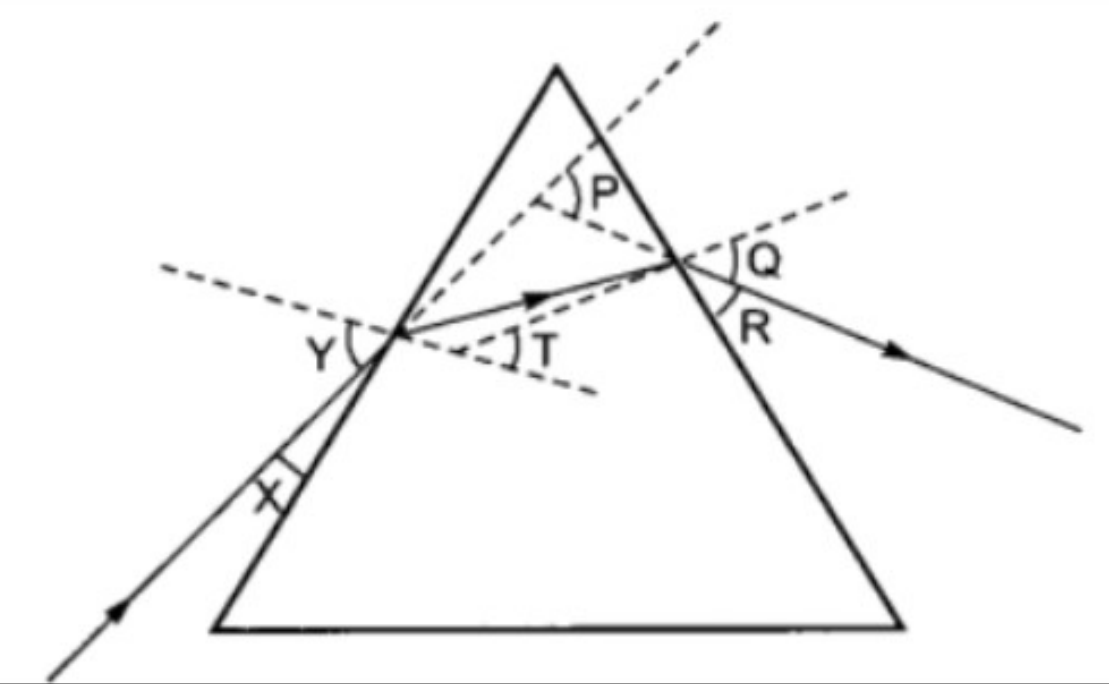
(a) X, R and T
(b) Y, Q and T
(c) X, Q and P
(d) Y, Q and P
Ans. (d) Y, Q and P
Q23. Light enters from air into water which has a refractive index of 1.33. Calculate the speed of light in water. The speed of light in air is 3.0 x 108 m/s.
(a) 2 x 108 m/s
(b) 6 x 108 m/s
(c) 7 x 108 m/s
(d) 8 x 108 m/s
Ans. (a) 2 x 108 m/s
Q24. A person cannot see distinctly objects kept beyond 2 m. This defect can be corrected by using a lens of power
(a) + 0.5 D
(b) - 0.5 D
(c) + 0.2 D
(d) - 0.2 D
Ans. (b) - 0.5 D
Q25. A concave mirror produces three times magnified real image of an object placed at 10 cm in front of it. The image is located at
(a) 30 cm
(b) 40 cm
(c) 10 cm
(d) 90 cm
Ans. (a) 30 cm
Q26. Velocity of light in air is 3 x 108 m/s. While its velocity in a medium is 1.5 x 108 m/s. Then, refractive index of this medium is
(a) 3
(b) 5
(c) 0.5
(d) 2
Ans. (d) 2
Q27. Speed of light in vacuum is 3 x 108 m/s Then, speed of light in glass (refractive index 1.5) will be
(a) 4.5 x 108 m/s
(b) 2.0 x 108 m/s
(c) 3.0 x 108 m/s
(d) 2.0 x 108 m/s
Ans. (d) 2.0 x 108 m/s
Q28. For the same angle of incidence of 45°, the refraction angle in two transparent media P and Q is 20° and 30°, respectively. Which medium is optically denser out of P and Q. Why?

Q29. A student sitting on the last bench can read the letters written on the blackboard but is not able to read the letters written in his textbook. Which of the following statements is correct?
(a) He should wear concave lens.
(b) He should wear plane lens.
(c) He should wear bifocal lens.
(d) He should wear convex lens.
Ans. (d) He should wear convex lens.
Q30. When a beam of white light passes through a glass prism, it splits up into seven colours. This phenomenon is due to
(a) refraction of light
(b) dispersion of light
(c) diffraction of light
(d) absorption of light
Ans. (b) dispersion of light
Q31. Which of the following diagrams represents refraction of light through a prism correctly?

Q32. When the light is very bright
(a) the iris makes the pupil expand.
(b) the iris makes the pupil contract.
(c) ciliary muscles contract to make the eyelens thicker.
(d) ciliary muscles expand to make the eyelens thinner.
Ans. (b) the iris makes the pupil contract.
Q33. The magnification of an image formed by a lens is – 1, If the distance of the image from the optical centre of the lens is 25 cm, where is the object placed? Find the nature and focal length of the lens. If the object is displaced 15 cm towards the optical centre of the lens, where would the image be formed? Draw a ray diagram to justify your answer.
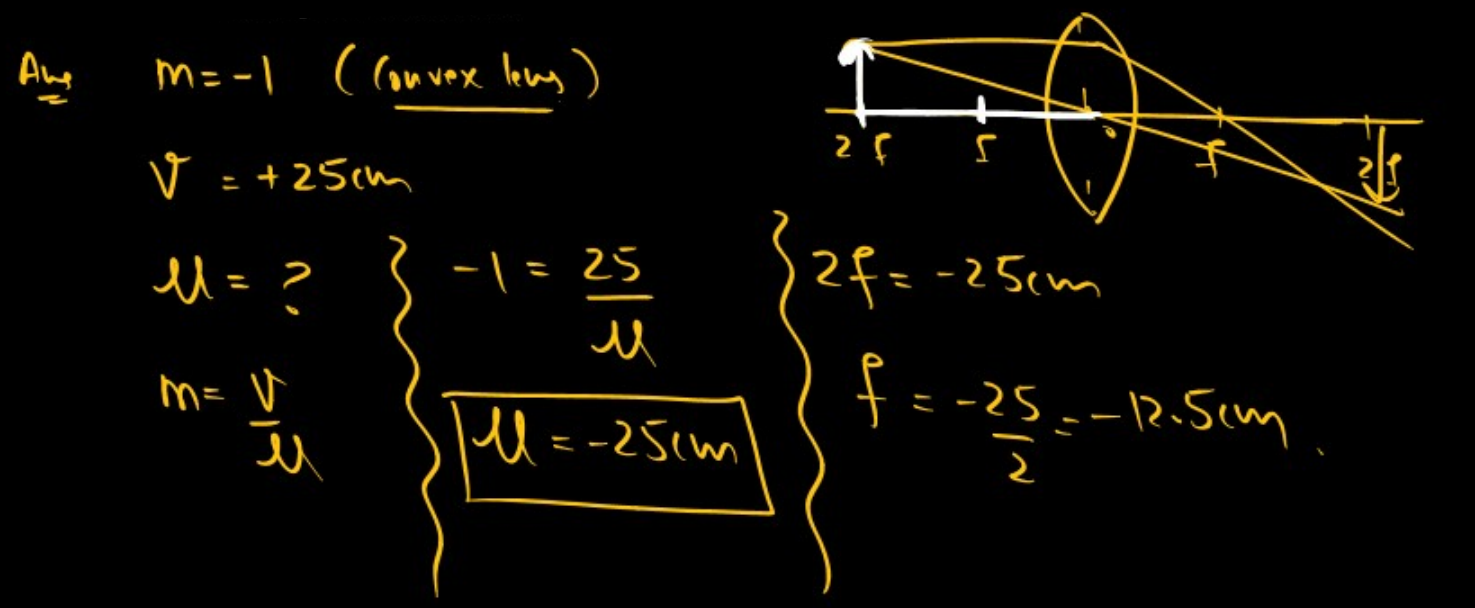
Q34. A real image 2/3rd of the size of an object is formed by a convex lens when the object is at a distance of 12 cm from its focal length of the lens
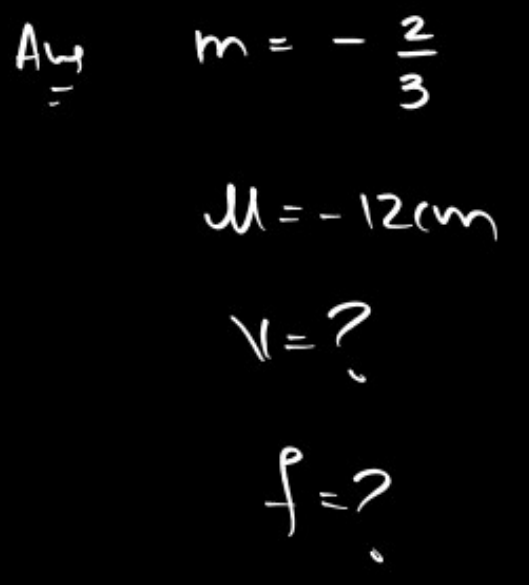
Q35. An object 5.0 cm in length is placed at a distance of 20 cm in front of a convex mirror of radius of curvature 30 cm. Find the position of the image, its nature and size
Q36. An object of size 7.0 cm is placed at 27 cm in front of a concave mirror of focal length 18 cm. At what distance from the mirror should a screen be placed, so that a sharp focussed image can be obtained? Find the size and the nature of the image.
Q37. Assertion: The nature of the image formed by a concave mirror is real and inverted.
Reason: The image formed by a concave mirror depends on the position of the object.
(a) both assertion and reason are true and reason the correct explanation of assertion.
(b) both assertion and reason are true, but reason i not the correct explanation of assertion.
(c) assertion is true, but reason is false.
(d) assertion is false but reason is true.
Q38. Assertion: Convex mirror are used for rear view on vehicles.
Reason: The size of the image formed by a convex mirror will be same.
(a) If both assertion and reason are true and reasonthe correct explanation of assertion.
(b) If both assertion and reason are true, but reason i not the correct explanation of assertion.
(c) If assertion is true, but reason is false.
(d) If If assertion is false but reason is true.
Q40. "The magnification produced by a spherical mirror is - 3". List four informations you obtain from this statement about the mirror/image.
Q40. The near point of a hypermetropic eye is at 75cm from the eye, what is the power of the lens required to enable him to read clearly a book held at 25cm from the eye?
-
👉 CBSE Class 10 Study Materials
| CBSE Class 10 Syllabus 2024-25 | NCERT Solutions For Class 10 |
| CBSE Class 10 Previous Year Question Papers | CBSE Class 10 Books |
| CBSE Class 10 Full Study Material | CBSE Class 10 Sample Paper |







 Profile
Profile Signout
Signout










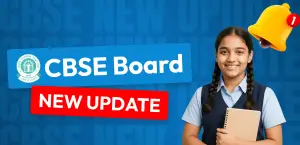

 Quiz
Quiz
 Get latest Exam Updates
Get latest Exam Updates 










